|
|
|
Production Notes - On Her Majesty's
Secret Service
With Sean Connery having packed
his bags and (temporarily) moved on to pastures new, the caretakers
of the James Bond franchise were
faced with a dilemma - Connery had become so firmly entrenched
in the public psyche as the big screen Bond that replacing him
was
going to be a daunting task. By October 1967, EON Productions had
resigned itself to the fact that Connery simply wasn't coming
back
to the fold and had begun the process of tracking down their new
Bond.
By April of the following year, Broccoli and Saltzman had drawn
up a list of some 100 actors they wanted to screen test and set
about seeing as many of them as possible. Future Bond Timothy
Dalton was among their number, as were Hans De Vries, Robert Campbell
and John Richardson, and a year previously, Saltzman had mentioned
his desire to see Roger Moore take over the mantle, though his
work on TV's The Saint more or less ruled that out at the time.
The part eventually went to an unknown Australian, 28 year old
model George Lazenby who had blagged his way into an interview
with Saltzman and, through judicious bending of the truth, had
persuaded the producer that he was the man for the job.
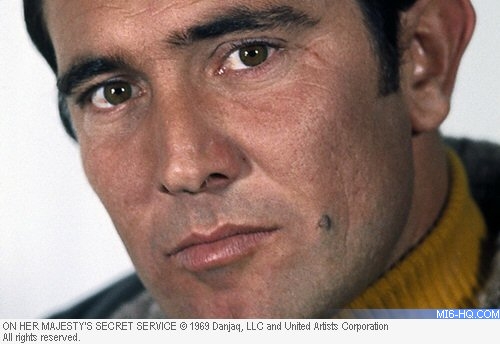
Above: George Lazenby as James
Bond.
|
So keen for the part was Lazenby that he even went to Broccoli's
barbers in Mayfair to have his hair styled after Connery's. During
his audition, which required him to attack former wrestler Yuri
Borienko, Lazenby actually broke his opponent's nose, impressing
director Peter Hunt with his physical strength and presence.
|
Hunt had been a long-standing player in the Bond series,
initially as an editor and, on You
Only Live Twice (1967),
as a second unit director. Saltzman and Broccoli had long
promised Hunt the chance to direct the main unit of a Bond
film and, with a new front man stepping in, he was given
the chance to continue a clean sweep of changes.
Hunt was re-united with another Bond 'old
boy', Richard Maibaum, back in the fold after missing out
on You Only
Live Twice and here writing his fifth Bond script.
Maibaum had originally planned to introduce Lazenby with
a plastic surgery sub-plot. In his first draft, Bond was
to undergo the surgery at the very beginning of the film,
his appearance being changed because his face was now too
well known to his enemies. Thankfully, the idea was quickly
dropped.
Maibaum was assisted by Simon Raven, the
author of the novel Doctors Wear Scarlet, filmed by Robert
Hartford-Davis as Incense For the Damned (1969), who was
commissioned to work over some of Maibaum's dialogue. Hunt
too would have his say in the script, adding new material
throughout the film's protracted shoot, and expert advice
was sough from the College of Arms in London to lend some
realism to the scenes where Bond has to pass himself off
as an expert in genealogy. |
|
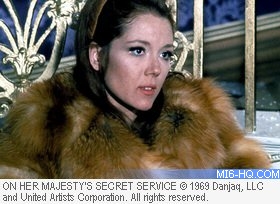
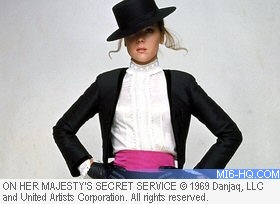
Above:
The leading lady of "On Her Majesty's Secret Service"
- Diana Rigg as Tracy.
|
Lazenby
got the first chance in the series to show a different
side to Bond's persona when, in the film's closing
stages, he
falls in love with and marries the doomed Contessa Teresa de
Vincenzo. To play this demanding role, Broccoli
had originally wanted Brigitte
Bardot but that avenue was cut off when she signed up for Edward
Dmytryk's Shalako with, ironically, Sean Connery.
In her place,
EON pursued Catherine Deneuve but she was adamant that she simply
wouldn't even consider the part. Eventually, the role went to the second ex-Avenger (after Goldfinger's
Honor Blackman) to appear in the series, Diana
Rigg, who had only
recently given up her iconic role as the incomparable Emma Peel.
Rigg turned out to be the perfect choice, bringing an emotional
depth to the role that may well have been missing from anyone
else. Her vast experience in film, theatre and television, would
help underpin the film and deflect the acting burden away from
the inexperienced Lazenby.
|
Although Lazenby received much support from Broccoli and
Saltzman, he had a less easy ride from the board of United
Artists who were none too keen to see him take over the
mantle of Bond. On 7 July 1968, test footage of Lazenby
and Rigg had been sent to United Artists in New York -
and the were less than impressed by what they saw. On 23
September 1968, UA's head man David Picker even flew into
London, desperate to tempt Connery back into the fold.
But Connery was adamant that he wasn't coming back - EON
and UA had made him a star and Connery was now a major
player, capable of picking only the roles that interested
him. And at this moment, Bond simply didn't interest him
at all. It was only reluctantly that UA accepted EON's
recommendation that Lazenby be given the part.
EON now had to face the press and break
the news that this total unknown was going to take over
as Bond. After
a course of elocution and acting lessons, Lazenby was packed
off to the Riviera for a short break while EON publicists
prepared for the great unveiling, which was announced to
the public by the press on 3 October. EON then moved to
snap up the advertising material that Lazenby had previously
modeled for, hoping to suppress it so as not to distract
from their new Bond's image. |
|
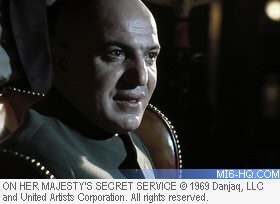
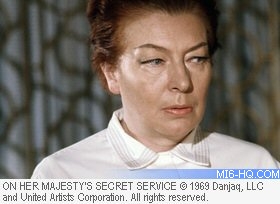
Above:
007's nemesis Blofeld is played by Telly Savalas, and
his right-hand woman Irma Bundt
(Ilse Steppat).
|
Lazenby was formally introduced to the world at a press conference
on Monday 7 October at the Dorchester Hotel. A second press junket
was staged at the Hilton's Roof Restaurant on the 13th of the
month where Lazenby posed with his two co-stars, Rigg and American
actor Telly Savalas who was to replace Donald
Pleasance as Blofeld. Eight days after the Hilton press conference, on Monday 21 October
1968, the crew of On Her Majesty's Secret
Service assembled in
Switzerland to begin principal photography. OHMSS was a considerably
more frugal production than the lavish You Only Live Twice and,
sadly, one of the casualties of the cost-cutting was Ken Adam,
whose magnificent sets were to be forsaken this time round. Instead,
the film's main location, Blofeld's mountain top lair, was represented
by a massive circular restaurant, an architectural folly perched
almost 10,000 feet above sea level on one of the peaks of the
Swiss Schiltorn mountain range. EON had to pay out for a complete
interior refit to get the look that production designer Syd Cain
was after when the Swiss authorities refused planning permission
for his original plans and a fully functioning helicopter pad
also had to be built at EON's expense. This still proved cheaper
than paying for another set of Adam extravagances however. As shooting got under way, it soon became clear that this wasn't
going to be an easy ride for anyone. Lazenby, still a little phased
by the amount of attention he was getting from the world's press,
found it particularly stressful and he later accused Hunt of failing
to give him the guidance he felt he needed. There was also reports
of some friction between Lazenby and the rest of the cast and
by January 1969, some three months into shooting, the actor still
hadn't actually signed his contract with EON. United Artists had
wanted him to sign up for seven films, but all Lazenby would offer
them was a letter of intent while he had a lawyer friend pick
through the hefty contract he had been presented with. Working in the rarefied air of
Murren, a tiny Swiss village which suddenly found
itself invaded by Bond personnel, made strenuous
work uncomfortable and an accident with a cable car stunt, which
left Lazenby's double George Leech with a dislocated
arm just
added to the tension. Then, to add to the crew's miseries, an
unexpectedly mild winter set in and the snow disappeared,
forcing
the production to close down altogether for a while. Hunt and
the main unit decamped to Pinewood and a second
unit team was
dispatched back to Switzerland in January to complete pick-up
shots.
The most pressing problem for EON throughout
January 1969 was Lazenby, and more specifically the reports
that had started to appear in newspapers around the world
about his behaviour on set.
Rumours began to spread of
an increasingly bitter dispute between Lazenby and Rigg,
though many of them were exaggerations and distortions.
The press specifically picked up on one incident in which
Rigg, about to film the romantic scene wherein Bond proposes
to Tracy, shouted to Lazenby across the set that she's
be having garlic for lunch. Inevitably, this playful
remark was misrepresented as a genuine falling out between
the
two stars.
According to Lois
Maxwell, however, the truth was rather
different. Lazenby was rumoured to be "emotionally
involved" with Rigg but was an uncompromising womaniser
which made a tense working environment even less palatable.
The press, eager for gossip, picked up on unsubstantiated
rumours and ran with them and the situation was muddied
further when Lazenby and Rigg, apparently deliberately,
gave different accounts of their relationship to different
reporters.
|
|
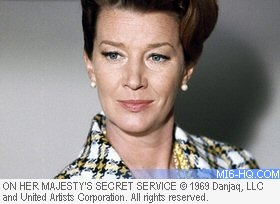
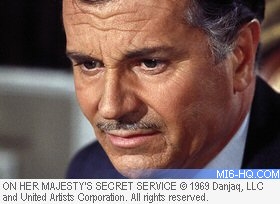
Above: Bond's allies Miss Moneypenny
(Lois Maxwell) and Marc Ange Draco (Gabriele Ferzetti).
|
By the time February rolled around, Hunt was falling behind
in his schedule and asked John Glen, the film's editor, to come
to the set and act as his second unit director. Glen later suggested
that the film was falling behind because of all of the action
scenes necessary to distract audiences away from the fact that
Lazenby wasn't much of an actor. More problems were encountered when Hunt came to shoot the bob
sleigh chase. Originally, it was set to be shot at the famous
Cresta Run in St Moritz, but the location was judged to be unsuitable
due to its very public nature - everyone knew where the run was
and there was open access to the site. EON therefore brought in
bob sleigh champion Franz Capose to build a special two mile run
near the main location in Murren, using an existing run that had
been closed down in 1937 for being too dangerous. Clearly this was adding to the expense and with the main unit
having problems of their own, Glen was assigned the unenviable
task of getting the bob sleigh sequence shot as quickly as possible.
Glen had never met Broccoli until the day the producer arrived
on the set and insisted that he be allowed to try out the newly
built run for himself. After importing huge amounts of ice from Berne to replace that
which was melting at Murren, Glen was ready to shoot the sequence,
his first of many for EON. With multiple camera crews in place
(including an aerial team headed by John Jordan, back with EON
after his accident on You Only Live Twice), the bob sleighs set
off with bob sleigh champion Heinz Lau and Olympic skier Robert
Zimmerman acting as doubles for Lazenby and Savalas respectively. But the mild weather had made the ice unpredictable and as Lau
careered around a particularly tight bend, his sleigh left the
run, throwing Lau into the path of Zimerman's sleigh. Zimmerman
himself tried to avoid hitting Lau, resulting in a collision that
left him with facial injuries. The accident was captured on film
by pursuing cameraman Willy Bogner Jr, himself a former Olympic
downhill racer, and the footage actually appears in the finished
film. While all this was going on, Anthony Squires was at nearby Lauterbrunnen
staging the stock car sequence. The second unit then set up at
Grindelwald where they staged the sequence where Bond meets Tracy
while ice skating - Lazenby had been told by the production's
insurance company that he was not to take part in the skating
sequence though the actor was keen to take part in as many of
the stunts as possible. Next on the agenda was the spectacular ski sequence as Bond
and Tracy make good their escape from a barn, hotly pursued by
Blofeld's agents on skis. The sequence was filmed by Willy Bogner
and orchestrated by Glen over five gruelling nights near the
village of Winteregg.
Hunt now had to stage one of the most spectacular and
dangerous of all of the film's many action sequences, the
avalanche that engulfs Bond and Tracy. As long ago as summer
1968, Hunt had had the Swiss army plant explosive charges
in the snow and had patiently waited for the winter snows
to completely cover them ready for the stunt in Spring
1969. But things were slightly awry - while the second
unit was filming the bob sleigh sequence, the avalanche
happened naturally, ruining all the preparation. A desperate
Glen tried to create a convincing avalanche using a snowplough
and even tried setting off the charges anyway to see what
would happen. The avalanche seen in the finished film is
made up mostly of stock footage combined with a smaller
avalanche that Glen was able to rig up in May.
While Glen and Hunt grappled with nature in Switzerland,
Saltzman and Broccoli had more prosaic but no less serious
problems to deal with. Lazenby was still dragging his heels
and refusing to sign his contract. Saltzman became so desperate
to ensure Lazenby's commitment to the series that he started
offering him financial incentives while United Artists
offered to give Lazenby any film he wanted if he signed
on the dotted line. |
|
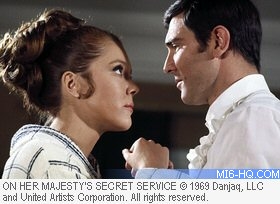
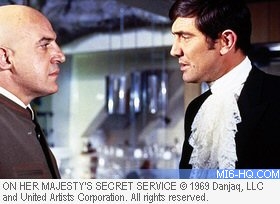
|
But by now, Lazenby was taking advice from Ronan O'Reilly, a
some time film producer and head of Radio Caroline who was urging
the actor not to sign his contract. In O'Reilly's view, the Bond
films were a spent force, unwanted by the new late-60s generation. Lazenby was finding all this conflicting advice confusing and
he turned to Peter Hunt for his opinion, putting the director
in a rather awkward position. United Artists were growing impatient
and were leaning on Saltzman and Broccoli. They in turn piled
the pressure on Lazenby and, inevitably, he jumped the wrong way.
Lazenby opted to listen to O'Reilly and his other advisors and
announced to the producers that OHMSS would be his solo outing
as James Bond. Before Lazenby could hang up his tuxedo for good, he still had
a lot of work to do on OHMSS. Pick ups and inserts were finished
in Switzerland before the production returned, temporarily, to
their base at Pinewood. During the second week of April, the
crew found themselves in Marlow, ten miles from the studio, where
the house Thames Lawn was to stand in for M's home.
The globetrotting resumed at the end of
the month when the production headed out to Estoril in
northern Portugal where Bond's marriage to Tracy was filmed
at the Palacio Hotel.
Just down the coast at Guincho Beach,
Lazenby shot his pre-credit fight with the goons trying
to abduct Tracy. Also shot in Portugal was Draco's birthday
party which was staged at the De Vinho estate in Zambujlal. Portugal was also the location for the most dramatic moment
in any Bond film, the shattering climax when Tracy is murdered
by Irma Bunt. Lazenby was allegedly kept awake all night
and cajoled into giving perhaps his finest performance
- so involved did he become that the first take, in which
Lazenby actually burst into tears, was abandoned in favour
of the more restrained and effective version seen in the
finished film.
Finally, on 23 June 1969, the lengthy and
traumatic shoot was over, almost two months past the
scheduled end date. But further
problems were awaiting the production. |
|

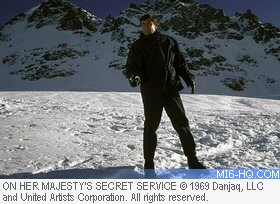
|
John Glen set to editing the footage that he and Hunt had shot
and it soon became clear that the film was not going to fit into
the usual under two hours running time. Glen's first cut came
in at 170 minutes and it was clear that a lot of footage had
to be sacrificed to make the film more manageable. Around 30 minutes of footage was discarded but even so, at 140
minutes, OHMSS was the longest 007 movie to date and was not to
be exceeded by any subsequent films. Broccoli and Saltzman opted
to leave the decision on cutting the film to the manager of the
Leicester Square Odeon - when shown a print, he was asked if anything
should be removed. Thankfully forsaking the chance to squeeze
in an extra screening each day, he suggested that the film be
released as it stood. Lazenby's Bond met his public for the first and only time as
Bond when the film was premiered at the Leicester Square Odeon
on Thursday 18 December 1969. Lazenby was in attendance along
with Rigg and disappointed many turning up with a decidedly un-Bond-like
shoulder length hair and a heavy beard. Though the film failed to match the box office stamina of the
previous films, it was certainly not the disaster that many critics
have sought to paint it as in the intervening years. It was the
most popular film in the UK throughout 1970, though globally it's
take was just over half that of You Only Live Twice, mainly due
to a relatively poor showing the States. It was becoming clear
to EON that, as Bond entered a new decade, something of an overhaul
was called for. |
|